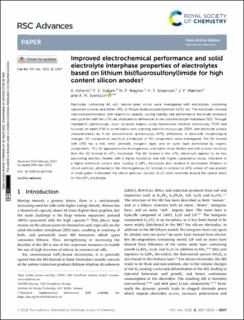| dc.contributor.author | Asheim, Karina | |
| dc.contributor.author | Vullum, Per Erik | |
| dc.contributor.author | Wagner, Nils Peter | |
| dc.contributor.author | Andersen, Hanne Flåten | |
| dc.contributor.author | Mæhlen, Jan Petter | |
| dc.contributor.author | Svensson, Ann Mari | |
| dc.date.accessioned | 2022-06-01T13:41:44Z | |
| dc.date.available | 2022-06-01T13:41:44Z | |
| dc.date.created | 2022-05-05T10:00:29Z | |
| dc.date.issued | 2022 | |
| dc.identifier.citation | RSC Advances. 2022, 12 (20), 12517-12530. | en_US |
| dc.identifier.issn | 2046-2069 | |
| dc.identifier.uri | https://hdl.handle.net/11250/2997262 | |
| dc.description.abstract | Electrodes containing 60 wt% micron-sized silicon were investigated with electrolytes containing carbonate solvents and either LiPF6 or lithium bis(fluorosulfonyl)imide (LiFSI) salt. The electrodes showed improved performance, with respect to capacity, cycling stability, rate performance, electrode resistance and cycle life with the LiFSI salt, attributed to differences in the solid electrolyte interphase (SEI). Through impedance spectroscopy, cross sectional analysis using transmission electron microscopy (TEM) and focused ion beam (FIB) in combination with scanning electron microscopy (SEM), and electrode surface characterization by X-ray photoelectron spectroscopy (XPS), differences in electrode morphological changes, SEI composition and local distribution of SEI components were investigated. The SEI formed with LiFSI has a thin, inner, primarily inorganic layer, and an outer layer dominated by organic components. This SEI appeared more homogeneous and stable, more flexible and with a lower resistivity than the SEI formed in LiPF6 electrolyte. The SEI formed in the LiPF6 electrolyte appears to be less passivating and less flexible, with a higher resistance, and with higher capacitance values, indicative of a higher interfacial surface area. Cycling in LiPF6 electrolyte also resulted in incomplete lithiation of silicon particles, attributed to the inhomogeneous SEI formed. In contrast to LiFSI, where LiF was present in small grains in-between the silicon particles, clusters of LiF were observed around the carbon black for the LiPF6 electrolyte. | en_US |
| dc.language.iso | eng | en_US |
| dc.publisher | Royal Society of Chemistry | en_US |
| dc.rights | Navngivelse 4.0 Internasjonal | * |
| dc.rights.uri | http://creativecommons.org/licenses/by/4.0/deed.no | * |
| dc.title | Improved electrochemical performance and solid electrolyte interphase properties of electrolytes based on lithium bis(fluorosulfonyl)imide for high content silicon anodes | en_US |
| dc.type | Peer reviewed | en_US |
| dc.type | Journal article | en_US |
| dc.description.version | publishedVersion | en_US |
| dc.rights.holder | © 2022 The Author(s). Published by the Royal Society of Chemistry | en_US |
| dc.source.pagenumber | 12517-12530 | en_US |
| dc.source.volume | 12 | en_US |
| dc.source.journal | RSC Advances | en_US |
| dc.source.issue | 20 | en_US |
| dc.identifier.doi | 10.1039/d2ra01233b | |
| dc.identifier.cristin | 2021663 | |
| dc.relation.project | Norges forskningsråd: 255195 | en_US |
| dc.relation.project | Norges forskningsråd: 245963 | en_US |
| dc.relation.project | Norges forskningsråd: 197405 | en_US |
| cristin.ispublished | true | |
| cristin.fulltext | original | |
| cristin.qualitycode | 1 | |

